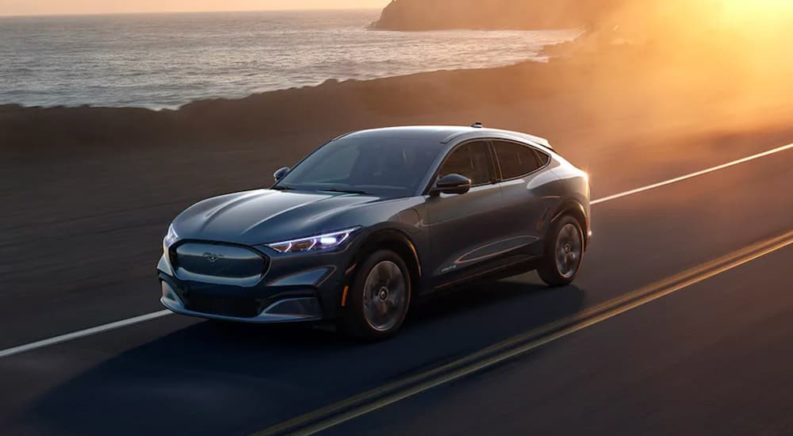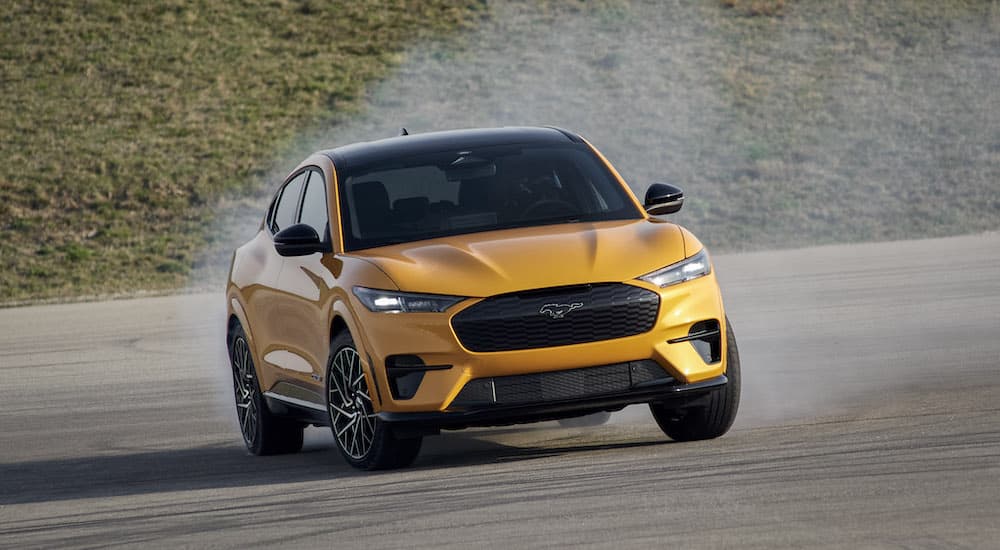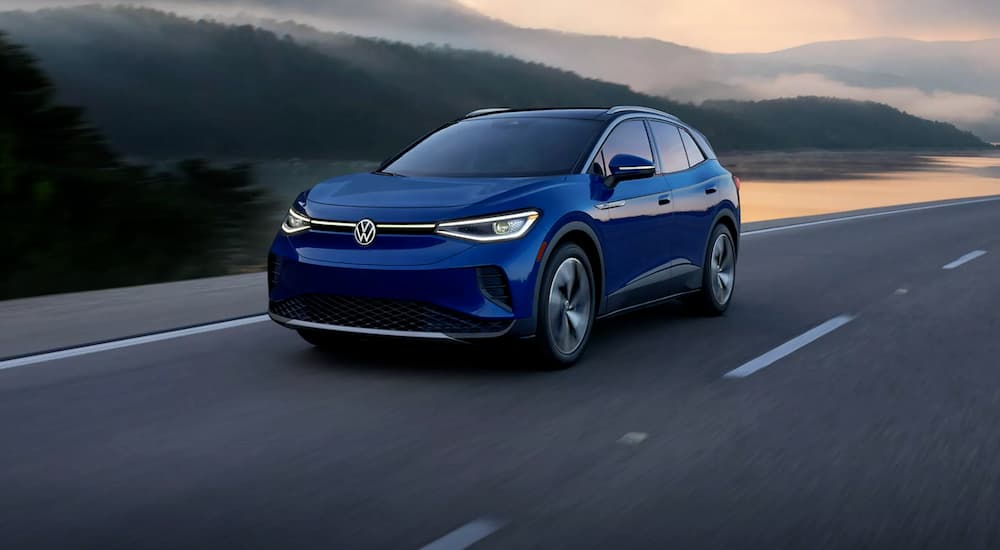Self-driving cars are quickly becoming a reality, making our roads safer and more convenient to travel. We aren’t there quite yet, but we’re well on our way with certain vehicles blazing ahead at the front of the trail. In a race to see who can go driverless first, the 2022 Ford Mustang Mach-E vs 2022 Volkswagen ID.4 are pretty close to being neck and neck. Is either one closer? How would we measure that? The Society of Automotive Engineers helps answer these questions for us, creating a system to categorize the level of autonomy of vehicles.
SAE Levels of Driving Automation
Level 0 – Level 0 vehicles don’t really have any driving automation. Their features will be limited to alerts or momentary assistance in emergency situations. They may have safety features like pedestrian braking or blind spot monitoring.
Level 1 – Vehicles that fall in SAE’s Level 1 are still not driving around sans-human, but they do have more features that are aimed at driver assistance rather than just safety. Examples include adaptive cruise control OR lane centering.
Level 2 – Level 2 vehicles are very similar to Level 1, except they pair driver assistance technologies like adaptive cruise control AND lane centering.
Level 3 – While the differences between Level 0, Level 1, and Level 2 feel minute, the difference from Level 2 to Level 3 is a pretty big leap. Beginning with Level 3, cars are pretty much driving solo. The operator of a Level 3 vehicle will only need to take over in certain circumstances.
Level 4 – In Level 4 vehicles, steering wheels and pedals are optional because these bad boys can drive themselves. Like Level 3, though, there may be certain locations, times, weather, etc., that prevent the vehicle from driving.
Level 5 – Level 5 vehicles can do it all; no driver necessary. They can go anywhere, anytime, turning a potential driver into a passenger, so they can kick back and play Sudoku while they get on their merry way.
2022 Ford Mustang Mach-E: Level 2 – Level 3ish
The Ford Mustang Mach-E is an exciting addition to Ford’s budding lineup of electric vehicles (EVs). Calling it “Mustang-inspired” is probably more accurate than calling this electric SUV an actual Mustang, but nomenclature aside, it’s fully loaded with power and technology. It’s equipped with Ford CoPilot 360, which lands the Mustang Mach-E in Level 2 of the SAE’s hierarchy of the driverless, with toes starting to get dipped into Level 3. Today, Ford CoPilot 360 is a sophisticated suite of safety features, but it’s laying the groundwork for future self-driving Fords to come. In addition to the following, it also includes a rearview camera, automatic high beams, and blind spot monitoring.
360 Degree Camera With Split-View and Front Washer
The 360 Degree Camera gives a full view of the vehicle’s immediate environment, as the name implies. There’s also an aerial view of the vehicle and its surroundings. Cameras mounted in the grille, tailgate, and side-view mirrors work together to create 6 different camera views (3 in the front, 3 in the rear). Stuffing a bunch of cameras inside of our cars can feel a little Big Brother, but a vehicle needs eyes if it’s going to drive itself. It’s also worth mentioning that if those eyes get dirty, a washing mechanism will spray the front camera off with the push of a button.
Pre-Collision Assist With Automatic Emergency Braking
Ford’s Pre-Collision Assist with Automatic Emergency Braking works much like other forward collision alert systems. If a potential front collision is detected, an alarm will signal that to the driver. If necessary, the car will automatically brake to avoid or lessen the impact. Our driverless cars will, ideally, be able to avoid getting into accidents.
Post-Collision Braking
Nobody’s perfect, and we can expect even the most sophisticated AI to miscalculate every now and then. In which case, damage control is the next best thing. If an accident does occur, the car will automatically brake if it senses other vehicles in the area. This can help to prevent secondary accidents after the first collision.
Intersection Assist
Intersections can be tricky, making them an accident hot spot. In a perfect world, everyone would yield the right of way when making their left turns, but sometimes we misjudge, don’t see things, or just plain have bad days. Regardless of whether your glasses prescription needs to be updated or you just spilled coffee down the front of your shirt, Intersection Assist will kick in the brakes when the vehicle is making a left turn and traffic coming from the opposite direction is detected. We can assume that self-driving cars will need to turn left sometimes, so it’s good to know that the technology for this specific scenario is actively being worked on.
BlueCruise
BlueCruise is that borderline Level 3 autonomous driving technology I was talking about. With the help of adaptive cruise control with stop-and-go, lane centering, and speed sign recognition, drivers are able to go hands-free on 130,000 approved miles of road. Drives can’t completely slack off though – there’s a camera inside the vehicle that monitors the driver to make sure their eyes stay on the road. Big Brother is watching.
2022 Volkswagen ID.4: Level 2
The aptly-named IQ.Drive is a set of smart features designed to make driving the 2022 Volkswagen ID.4 safer and a little less involved. As of now, drivers are required to keep their hands on the wheel at all times, but Volkswagen is a tech-forward brand, so we can probably expect to see some hands-free capability in the near future. In the meantime, IQ.Drive offers plenty of driver assistance features, like lane assist, front collision assist, and more.
Emergency Assist
In the case that a driver becomes incapacitated, Emergency Assist will safely bring the vehicle to a stop after several alerts that go without response. It may go without saying, but a vehicle that is going driverless will need the ability to safely come to a stop in emergency situations.
Adaptive Cruise Control
By now, most of us have heard of this feature. It’s leveled-up cruise control that monitors the vehicles ahead to adjust driving speed and maintain a safe following distance. No more braking to abruptly end cruise control if someone merges in front of you at a slow speed or jamming on the steering wheel controls to get back up to speed one mph at a time. Being able to monitor the flow of traffic to maintain a fluid driving speed is a crucial element of any autonomous vehicle.
Rear Traffic Alert
Personally, backing out of a parking space is always good for a little shot of adrenaline. There’s nothing like creeping backward while trying to scan three different mirrors simultaneously just to slam on the brakes in time to avoid that person whizzing past you down the aisle. Rear Traffic Alert acts as a few extra sets of eyes, alerting the driver if a vehicle is detected crossing in their path. It may or may not save you the adrenaline spike. Once cars are fully capable of driving without my help, I’ll probably just keep my eyes shut while backing up.
Travel Assist
Travel Assist can be engaged when certain conditions are met, so while cruising on highways with clear lane markings. It activates active cruise control and keeps the vehicle centered in the lane, so the driver doesn’t have to worry about things like accelerating, braking, or steering. This is semi-autonomous, hands-on tech, though, so hands must be kept on the wheel, and those hands must be attached to a vigilant driver.
Leveling Up
The 2022 Ford Mustang Mach-E and 2022 Volkswagen ID.4 are both exciting examples of modern driving technology. Even though they’re not reaching the upper levels of autonomy on the SAE scale, they’re proof that that’s exactly what our vehicle manufacturers are reaching for. In the meantime, they’ll make driving safer, holding us over until the day we can take naps in our cars.






